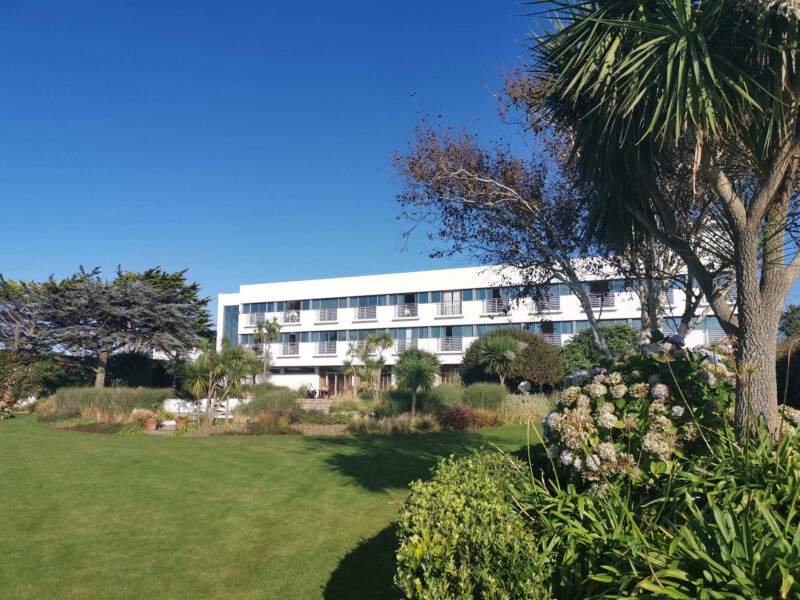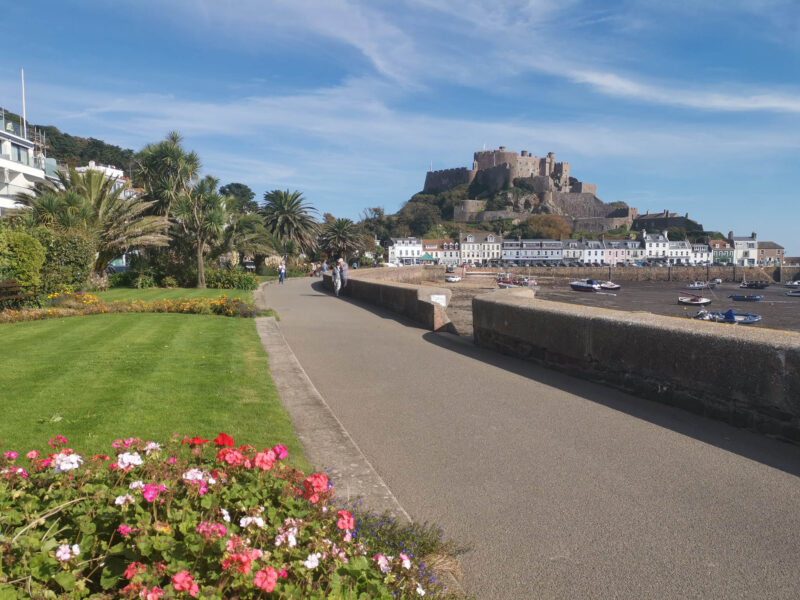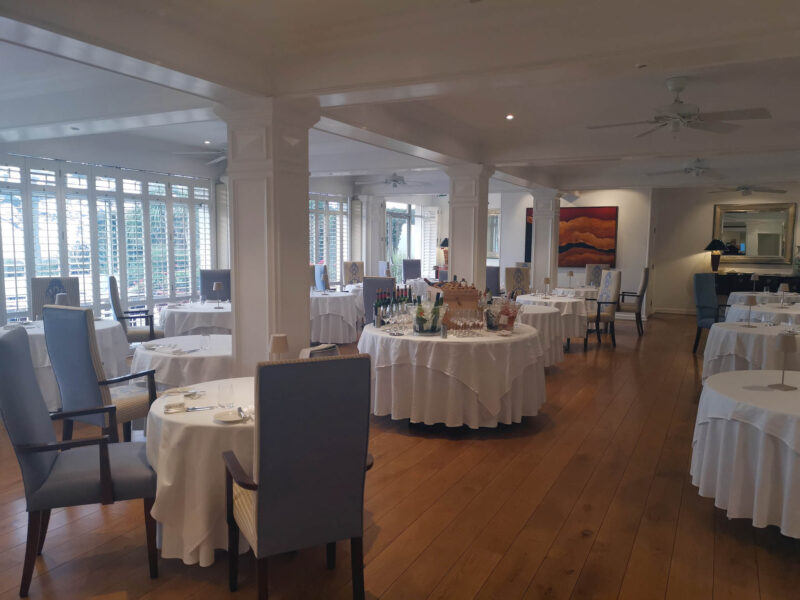Despite measuring just nine miles by five, Jersey is the largest of the Channel Islands as well as the archipelago’s southernmost isle. A self-governing dependency of the UK, it has much to offer visitors.
Known for, among other attractions, splendid beaches, rugged coastline, myriad walking trails, inland valleys, military history and a fine collection of superb cafes and restaurants, Britain’s sunniest spot has something for everyone.
I’ve been fortunate to visit several times but am always eager to return. For anyone considering a visit, here are five must-dos…
Check in to a classy hotel
You can’t beat The Atlantic Hotel
The Atlantic Hotel is a first class, family-owned hotel situated above St Ouen’s Bay on the island’s west coast. Its unbeatable location had me entranced the moment I saw the view from the step-on balcony – so make sure you book an Ocean View Room. Mind you, rooms on the other side of the building have a pretty impressive view, too.
For me, nothing beats staring out towards the Atlantic Ocean, listening to the soporific sound of the waves breaking on the beach below. The soothing vibe emanating from the ocean is matched by the relaxed atmosphere throughout the hotel.


This is a place which retains its timeless elegance, where staff firmly believe in service with a smile and guests are truly valued. Whenever I visit, it’s reassuring to know that I’m going to find a hotel where you’re guaranteed understated luxury.
So, if you get the chance to stay at The Atlantic Hotel, grab it with both hands because there’s no finer hotel on the island.
Go for a coastal walk
It’s claimed that you’re never more than ten minutes from the sea and Jersey’s coast and myriad beaches, which come in all shapes and sizes, are a major draw for visitors.
With a 40-mile coastline, there are plenty of beaches and rocky coves to discover. St Ouen’s Bay is among my favourites and I always enjoy strolling along its five-mile stretch of uninterrupted sand. Home to one of Europe’s oldest surfing clubs, a day doesn’t go by without spotting surfers riding the Atlantic rollers which crash onto the beach.


The island has some wonderful coastal walks, too. The wild north coast is particularly special. The energetic will enjoy trekking the entire 16 miles of coastpath from the northwest to the northeastern corner in one day. Most people, though, split it into manageable chunks.
One of my favourite walks heads out from the wonderful Atlantic Hotel and joins the coast path to Corbiere Lighthouse. Situated on the island’s southwestern corner, it was, allegedly, the world’s first concrete lighthouse.
Visit La Mare Wine Estate, Distillery & Cider Farm
Jersey may be diminutive but what it lacks in size it makes up for in other ways, including a highly-respected wine industry.
While output may seem insignificant in commercial export terms compared to more recognised viticultural regions, the island’s wine has its own fanbase, particularly among locals.
The primary producer – with a growing reputation beyond Jersey’s shores – is La Mare Wine Estate, a 20-acre plot nestled amid lush countryside in the north of the island. Here, a blanket of vines and apple trees (a popular apple brandy is also produced) surrounds an 18th century granite farmhouse.


The first vine was planted in 1972, marking the birth of Jersey’s only commercial vineyard. Before long, a distillery was added and the creation of genuine island produce, such as preserves and handcrafted confectionary, saw La Mare became an increasingly popular tourist attraction. Around 20,000 bottles of award-winning still and sparkling wine are produced annually.
Enjoy an informative guided tour, relax in the cafe or just enjoy admiring the grounds of this lovely estate. La Mare is well worth a visit.
Immerse yourself in the island’s history
Although I don’t regard myself as a history buff, I like to discover as much as possible about a destination’s past – and, boy, this island has plenty. Its more recent history involves German occupation during most of the Second World War.
A visit to the Jersey War Tunnels is recommended. Between 1941-44, forced labourers working in horrendous conditions dug nearly a mile of tunnels and chambers out of the rock, producing an underground network protected from air or land attack.
More history is evident in the shape of coastal fortifications dotted around the island. But for a glimpse into the island’s distant past, head for La Hougue Bie, where you’ll learn about Jersey’s Neolithic community 6,000 years ago.


Wander up to the medieval chapel sitting atop a prehistoric mound before checking out the treasures, including swords and spears, displayed in the geology and archaeology museum.
Jersey has a rich history so consider buying the Heritage Pass which allows access to three or four historic sites, such as Mont Orgueil Castle. Highly recommended, this medieval building with links to the English Crown boasts spectacular views along the island’s coastline and beyond to France.
Walk on the sea bed
Jersey has one of the world’s largest tidal ranges and at low tide the island nearly doubles in size. The ebbing and flowing create an ever-changing backdrop as the island transforms from turquoise bays to rocky, lunar-like landscapes.
But that’s not all: this twice-daily occurrence also creates low water habitats for rare sea creatures like ormers, a prized delicacy among many cultures. The massive tide changes mean walking offshore is only advisable if you have knowledge of the area and its dangerous, fast tides.


So, to truly experience the marine landscape, don wellies and book a tour with Walk Adventures, a local company which organises regular theme-based walks. I thoroughly enjoyed my walk with Trudie at La Roque, situated on the island’s southernmost point.
Here, the tide retreats more than two miles and reveals intriguing features such as Violet Bank, comprising puzzle-like gullies where coralline algae, with its purple hue, congrgates.
Dining out
Jersey has some superb cafes and restaurants catering for all tastes. Here are some of my favourites:
Ocean Restaurant
The Atlantic Hotel’s superb restaurant and the ideal venue for anyone celebrating a special occasion or simply wanting to dine at a restaurant where you’re guaranteed not only top-notch food but great service.
With its clean lines and white shutters framing beautiful views, the restaurant exudes a tranquil vibe you’ll struggle to match elsewhere on the island.

PizzaExpress
PizzaExpress has two restaurants on the island but my choice is always the branch overlooking St Brelade Bay. This gorgeous venue has long been a favourite with locals and visitors alike since opening more than 23 years ago.
In fact, I’d eat here just to enjoy the sumptuous view out across the beach but, of course, the food is equally delicious which is something you can always rely on when visiting PizzaExpress.

Off the Rails
Pizzas at Off the Rails are equally delectable, but the menu also affords diners the chance to sample tapas and generous-sized burgers. This is a great little restaurant, really quirky and located alongside the Railway Walk, where the island’s railway once ran.
Open since 2019, this wooden cabin-like building has inside and outdoor seating.

Ransom’s Garden Centre Tearoom & Restaurant
As well as an extensive lunch menu, Ransom’s offers a superb collection of cakes, including plenty of vegan options.
Family-run, this garden centre in St Martin opened its doors in 1966 and was born from the combined passion of Sarah Ransom – a qualified patisserie chef – and her mother.
The tearoom has seating for over 100 people and, as far as I could establish, there is nowhere else on the island where you can choose from such as wide choice of cakes.

Travel Info
Date visited: October 2024


Leave A Comment